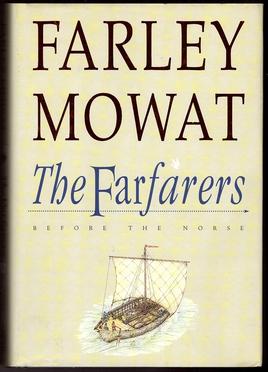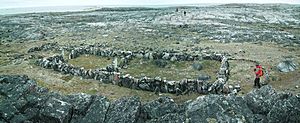The Farfarers facts for kids

Hardcover edition
|
|
| Author | Farley Mowat |
|---|---|
| Country | Canada |
| Language | English |
| Subject | Pre-Columbian trans-oceanic contact |
| Genre | Non-fiction |
| Publisher | Key Porter Books |
|
Publication date
|
November 1, 1998 |
| Media type | Print, e-book |
| Pages | 377 pp. (1st edition) |
| ISBN | 978-1550139891 |
The Farfarers: Before the Norse is a non-fiction book by Farley Mowat. It shares a theory that people from Europe visited North America long before Christopher Columbus or the Vikings. Mowat suggests that people from Orkney, an island group north of Scotland, were the first Europeans to reach Canada. They traveled across the Atlantic Ocean, using Iceland and Greenland as stops along the way. Mowat's ideas are interesting, but some people think they are based too much on guesses. In the UK, the book was published with the title The Alban Quest.
Contents
Who Were the Albans?
Farley Mowat believes that people from the northern British Isles explored and settled Iceland, Greenland, and North America before the Vikings. He calls these early explorers the Albans. This name comes from an old name for the British Isles. Mowat suggests that the Albans were descendants of the very first people who lived in Britain during the Neolithic Age (New Stone Age).
He thinks these Albans were pushed to the edges of Europe, like Northern Scotland, Orkney, and Shetland. This happened because other groups, like refugees from Armorica (a part of France) who were escaping the Romans, moved into their lands. These new groups built strong stone towers called brochs along the Scottish coasts. They became known as the Picts.
Mowat believes the Albans were skilled hunters, especially of walrus ivory. This valuable material was in high demand. The search for ivory led the Albans to discover Iceland, which they might have called Thule. This happened centuries before the Vikings arrived, as early as 330 BC. The Albans used special boats for long journeys. These boats had strong hulls (the main body of the boat) made from animal hides.
Alban Journeys to Iceland and Beyond
Mowat thinks that Albans started settling Iceland early in the first thousand years AD. After the Roman Empire left Britain, there was a lot of trouble and fighting. Threats from groups like the Scots and the Vikings caused many Albans to leave their homes. They moved to Iceland between the 5th and 7th centuries.
Looking for more ivory, Alban hunters explored the coasts of Greenland. They also traveled to places in Canada like Baffin Island, Ungava Bay, and Labrador. Eventually, they discovered Newfoundland. Mowat suggests that these hunters built temporary camps for winter. They would place their boats on top of stone foundations, like the one found on Pamiok Island.
Mowat believes the Albans met the Tunit people in the Canadian Arctic. He thinks some Albans even lived with the Tunit and married into their communities.
Mowat also suggests that the Vikings became interested in Iceland because they saw the valuable ivory and furs that Alban ships brought to Europe from there. He points to Viking stories, called Sagas, which say that when Vikings first found Iceland, people called the Papar already lived there. Early Viking explorers often hid in difficult places, as if the land was already settled by unfriendly people. When Vikings began to settle Iceland around 870 AD, many Albans moved again. They went to the fjords of southwestern Greenland and to central Labrador.
Albans in Newfoundland
Mowat believes the Albans discovered Newfoundland in the early 900s. Newfoundland had good land for farming and many walruses. This would have attracted Alban settlers, hunters, and traders from Greenland and Labrador. As these areas became less populated, a third large group of Albans moved to Newfoundland. This happened quickly when Vikings started appearing off the Greenland coast in the late 900s.
Mowat thinks the Albans mainly settled in southwest Newfoundland. They lived along the coast between Channel-Port aux Basques and Port au Port. News of this rich area reached the Vikings through traders. The Vikings called this place Hvítramannaland or Albania. Mowat suggests that Viking voyages by Leif Erikson and Thorfinn Karlsefni were partly attempts to raid Hvítramannaland. These attempts failed because they couldn't find it, or because they met hostile local people the Vikings called Skrælings.
Mowat suggests that the Albans lived in southwestern Newfoundland for several centuries. They kept some connections to Europe through trade and visits from religious leaders during the Middle Ages. This connection broke in the 14th century. The Albans became isolated until John Cabot's voyages and the start of European fishing around Newfoundland. Attacks by European pirates forced the Albans to move inland, possibly as far as King George IV Lake.
Mowat thinks that the Albans likely mixed with other groups over time. However, he suggests that a group of dark-skinned Newfoundlanders called the Jackatars might be their last descendants. The Jackatars' origins are not fully known, but they are often thought to be a mix of Mi'kmaq and Acadian peoples.
What People Thought of the Book
Canadian Geographic magazine published parts of The Farfarers in 1998. The editors called the book "a highly speculative blend of history and archeology." They noted that Mowat used old Norse stories, Irish monk records, Roman traveler accounts, and modern historical works. They said the book was detailed but also "sketchy" because there isn't much written or archaeological evidence from that time. However, they felt that such speculative writing could inspire new research. They mentioned that no professional archaeologists agreed with Mowat's theories, but that didn't bother him. Mowat was known for challenging experts and sparking debates.
Richard Ellis from The New York Times said that The Farfarers is worth reading. He thought it was good to experience a different idea of history, especially since it was written by a great storyteller.
Stuart C. Brown, an anthropology professor at Memorial University, commented on the book. He said that in prehistory, many things are possible, so Mowat's idea shouldn't be completely dismissed. But he pointed out that for an idea to be accepted, there needs to be strong evidence. Brown noted that there is no evidence at the Pamiok site that anyone other than the Tunit people used it. He concluded that while he enjoyed Farley Mowat's writing and his interest in Canada's past, the book was entertaining as fiction but not convincing as fact.


